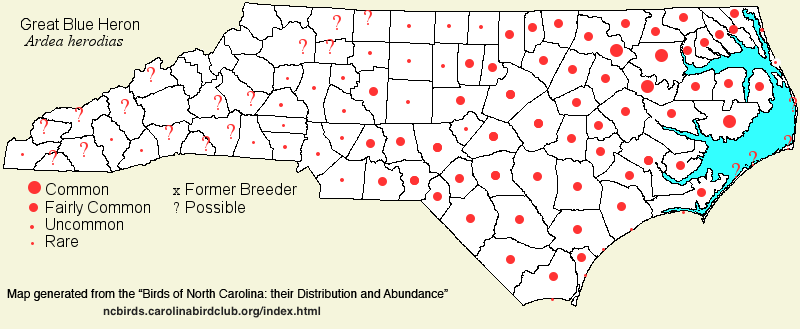 |  |
|
Great Blue Heron - Ardea herodias ARDEIDAE Members: | Search Common: Search Scientific: |
|
|
|||||||
| General Comments |
Our most familiar and frequently seen wader, the Great Blue Heron has shown a remarkable increase in numbers across the state since about 1980. In fact, it was very poorly known as a breeding species as late as the 1970's, with nesting colonies few and far between, mainly in remote swamps. However, with the great increase in beaver ponds, and a smaller increase in reservoirs and other man-made lakes and ponds, Great Blues have taken advantage of these new freshwater wetlands. Birds now nest in most of our counties away from the mountains, and nesting colonies are often easily visible around the upper ends of reservoirs and at beaver ponds. The species forages mainly at freshwater ponds, lakes, and streams; however, they also feed in brackish waters, especially at coastal impoundments, and rarely in salt water. Unlike most other waders, the Great Blue shuns nesting on coastal islands with other herons, egrets, and ibises. Instead, birds nest mostly by themselves, or with Great Egrets and/or Anhingas, with nests placed mainly in living trees -- almost always in standing water -- to deter predators.
NOTE: The "Great White Heron" (Ardea herodias occidentalis) subspecies has been found across the state on a number of occasions, all being single birds. | ||||||
| Breeding Status | Breeder | ||||||
| NC BRC List | Definitive | ||||||
| State Status | |||||||
| U.S. Status | |||||||
| State Rank | S5B,S5N | ||||||
| Global Rank | G5 | ||||||
| Coastal Plain |
Year-round resident throughout the province, with some populations migratory. Essentially common all year as a non-breeder, and locally common (and increasing) breeder, away from the immediate coast; nests in nearly all counties in the province. Peak counts: ?.
There are at least seven records of "Great White Heron": Goldsboro area, 8-26 Aug 1990; Pea Island NWR, 20 Jul 1994 - 30 Nov 1995; Johnston, 24 Apr 2010; Mattamuskeet NWR, 25 Jan 2013; Pea Island NWR, 23 Jul 2013; NC 94 at the Intracoastal Waterway (Hyde), 24 Jan 2014; and Cape Point (Dare), 6-20 Aug 2020. | ||||||
| Piedmont |
Year-round resident, breeding locally but in most counties; increasing at all seasons. Common over the eastern half, and fairly common in the western half, from Aug to Apr; less numerous, though still fairly common, as a breeder, being more widespread as a breeder in the eastern counties (such as around Falls and Jordan lakes, and lakes along the Yadkin/Pee Dee rivers). Peak counts: ?.
There are nine records of "Great White Heron": Crystal Lake near Durham, 2 Jul 1926 (specimen at the N.C. Museum of Natural Sciences); Greensboro, 6 Sep 1943; Lake Townsend (Guilford), 8-30 Jul 1987; Jordan Lake, 13-31 Aug 1988; near Raleigh, 21 Apr 1989; along the Eno River (Durham), 18 Nov 2011 - early Jan 2012; one along North Buffalo Creek (Guilford), 8 Aug - 9 Oct 2013; one at Lake Brandt (Guilford), 25-29 May 2017; one photographed at Harmon Field (Polk), 14-15 Nov 2021. | ||||||
| Mountains |
Nearly year-round resident, though generally rare to uncommon in late spring and early summer; breeding first noted in 2006, near Brevard, and also has nested in Jackson and Cherokee. Fairly common at lower elevations in spring and from July to Oct, but uncommon generally over 3,000 feet. Mostly uncommon by mid- to late winter. Peak counts: ?.
There are 10+ records of "Great White Heron": Brevard, 13 Jul 2000 - 25 Jan 2001; Transylvania, Apr 2008; Asheville, 7 Aug 2008; Avery Aug - 7 Oct 2008; and the French Broad River valley (Henderson), 17-25 Jul and 14 Aug 2018. Whether the three 2008 records represent separate birds seems unlikely. In 2020, singles were noted at Beaver Lake Bird Sanctuary (Buncombe) on 9 Jun, and along the Watauga River near Valle Crucis (Watauga) on 8 June and to 13 Sep. What likely was this last bird showed up at the same spot -- Watauga River -- from 17 Dec 2021 into spring 2022, obviously surviving the cold winter season in that area. One photographed at Spruce Pine (Mitchell) from 21-28 Sep 2022 could possibly have been the same bird seen a few months earlier not that far to the northeast. In 2024, a different (or same?) bird was noted on 9 Jun at Burnsville (Yancey) and again at Newland (Avery) from 13-28 Jul. | ||||||
| Finding Tips |
This widespread species can be seen daily in most regions from late summer through spring, and finding tips are not needed. **** | ||||||
| Attribution | LeGrand[2024-11-04], LeGrand[2023-03-19], LeGrand[2022-04-26] | ||||||
| NC Map Map depicts all counties with a report (transient or resident) for the species. | Click on county for list of all known species. |
| NC Breeding Season Map Map depicts assumed breeding season abundance for the species. |  |